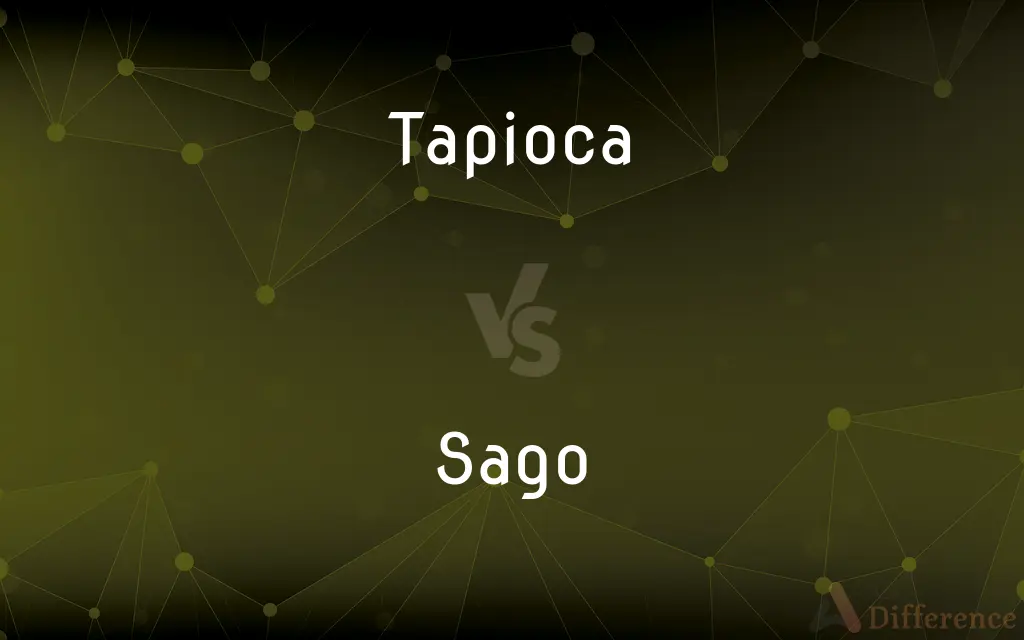Tapioca vs. Sago — What's the Difference?
By Fiza Rafique & Maham Liaqat — Updated on April 1, 2024
Tapioca is derived from the cassava root, while sago comes from the pith of various tropical palm trees.

Difference Between Tapioca and Sago
Table of Contents
ADVERTISEMENT
Key Differences
Tapioca is extracted from the roots of the cassava plant, predominantly found in South America, Africa, and Asia. It's processed into flour, flakes, and pearls. Sago, on the other hand, is obtained from the spongy center, or pith, of various tropical palm trees, mainly found in Southeast Asia and the East Indies.
Both tapioca and sago are used as thickening agents in cooking and baking, and as the main ingredient in various sweet and savory dishes. However, tapioca pearls are particularly popular in bubble teas and puddings, whereas sago is often used in traditional Southeast Asian desserts and soups.
In terms of nutritional content, both are almost entirely composed of carbohydrates, specifically starch, and have minimal protein or fat. They are also gluten-free, making them a popular alternative for those with gluten sensitivities.
While tapioca and sago can sometimes be used interchangeably in recipes due to their similar appearance and texture, their origin and cultural significance differ significantly. Tapioca tends to have a slightly more chewy texture, whereas sago pearls might become more translucent and softer when cooked.
Comparison Chart
Source
Cassava root
Pith of tropical palm trees
ADVERTISEMENT
Origin
South America, Africa, Asia
Southeast Asia, East Indies
Use in Cooking
Thickening agent, bubble tea, puddings
Thickening agent, traditional desserts, soups
Texture
Chewy when cooked
Soft and translucent when cooked
Nutritional Content
High in carbohydrates, gluten-free
High in carbohydrates, gluten-free
Cultural Significance
Used globally, notable in South American and Asian cuisine
Integral to Southeast Asian and Pacific cuisine
Compare with Definitions
Tapioca
A source of carbohydrates, offering minimal protein or fat.
Tapioca is a good energy source but lacks significant nutritional value.
Sago
Often used in puddings, soups, and traditional desserts.
Sago pudding is a common dessert in Malaysian cuisine.
Tapioca
A starch extracted from the cassava root, used widely in cooking.
Tapioca pearls are essential for making bubble tea.
Sago
A starch extracted from the spongy center of various tropical palm trees.
Sago pearls are a staple in many traditional Southeast Asian dishes.
Tapioca
Available in various forms such as pearls, flakes, and flour.
Tapioca flour is a popular gluten-free baking alternative.
Sago
Can be used as a thickening agent in various recipes.
Sago is added to soups to thicken them without altering the flavor.
Tapioca
Known for its chewy texture, especially in the pearl form.
The tapioca pearls added a chewy texture to the dessert.
Sago
Becomes soft and translucent when cooked.
The sago turned translucent after boiling, indicating it was ready.
Tapioca
Utilized for its thickening properties in recipes.
Tapioca is often added to pies as a thickening agent.
Sago
Provides carbohydrates and is gluten-free, similar to tapioca.
Sago is another gluten-free option for those with dietary restrictions.
Tapioca
Tapioca (; Portuguese: [tapiˈɔkɐ]) is a starch extracted from the storage roots of the cassava plant (Manihot esculenta, also known as manioc), a species native to the north and central-west regions of Brazil, but whose use is now spread throughout South America. The plant was brought by the Portuguese to much of West Indies, Africa and Asia.
Sago
Sago () is a starch extracted from the spongy centre, or pith, of various tropical palm stems, especially those of Metroxylon sagu. It is a major staple food for the lowland peoples of New Guinea and the Moluccas, where it is called saksak, rabia and sagu.
Tapioca
A starch made from cassava roots, usually processed as beads or flakes and used for puddings and as a thickening agent in cooking.
Sago
A powdery starch obtained from the pith of certain palm trees and cycads, used as a staple food chiefly in Asia and as a food thickener.
Tapioca
A dish, especially a pudding, made from this starch.
Sago
A powdered starch obtained from certain palms and used as a food thickener.
Tapioca
A starchy food made from the cassava plant, used in puddings.
Sago
A similar starch obtained from a palm-like cycad (Cycas revoluta)
Tapioca
The cassava plant, Manihot esculenta, from which tapioca is derived; manioc.
Sago
Any of the palms from which sago is extracted.
Tapioca
A coarsely granular substance obtained by heating, and thus partly changing, the moistened starch obtained from the roots of the cassava. It is much used in puddings and as a thickening for soups. See Cassava.
Sago
A dry granulated starch imported from the East Indies, much used for making puddings and as an article of diet for the sick; also, as starch, for stiffening textile fabrics. It is prepared from the stems of several East Indian and Malayan palm trees, but chiefly from the Metroxylon Sagu; also from several cycadaceous plants (Cycas revoluta, Zamia integrifolia, etc.).
Tapioca
Granular preparation of cassava starch used to thicken especially puddings
Sago
Powdery starch from certain sago palms; used in Asia as a food thickener and textile stiffener
Common Curiosities
Can tapioca and sago be used interchangeably?
Yes, in many recipes, tapioca and sago can be used interchangeably due to their similar texture and taste, though slight differences in texture may occur.
Which is healthier, tapioca or sago?
Both are primarily sources of carbohydrates with minimal nutritional differences. They are not significant sources of vitamins or minerals, so neither is considered superior in terms of health benefits.
How do you differentiate between tapioca pearls and sago pearls?
Tapioca pearls are often slightly more chewy and opaque, whereas sago pearls become more translucent and softer upon cooking. The differences can be subtle, making them hard to distinguish visually.
Are tapioca and sago gluten-free?
Yes, both are naturally gluten-free, making them popular alternatives for gluten-sensitive diets or those with celiac disease.
What is the environmental impact of cultivating cassava and palm trees for tapioca and sago?
Cultivation practices vary by region, but there are concerns about deforestation for palm cultivation and soil degradation with cassava. Sustainable practices are crucial for minimizing environmental impact.
Where are tapioca and sago most commonly found?
Tapioca is prevalent in South American, African, and Asian cuisines, while sago is a staple in Southeast Asian and East Indies culinary traditions.
Why are tapioca and sago popular in gluten-free diets?
Due to their lack of gluten and versatility in recipes, they are excellent alternatives for those avoiding gluten while still providing a similar texture and filling quality as gluten-containing grains.
What are the main culinary uses of tapioca and sago?
Tapioca is widely used in bubble teas, puddings, and as a thickening agent. Sago is primarily used in traditional Southeast Asian desserts, soups, and puddings.
Can you cook tapioca and sago the same way?
Yes, the cooking methods for tapioca and sago pearls are similar, involving boiling until they reach the desired texture, though cooking times may vary slightly.
How do tapioca and sago contribute to cultural cuisines?
Tapioca and sago hold cultural significance in their regions of origin, featuring prominently in traditional recipes and celebrations, highlighting their importance beyond mere culinary use.
Share Your Discovery

Previous Comparison
Cushty vs. Cushy
Next Comparison
Sledding vs. SledgingAuthor Spotlight
Written by
Fiza RafiqueFiza Rafique is a skilled content writer at AskDifference.com, where she meticulously refines and enhances written pieces. Drawing from her vast editorial expertise, Fiza ensures clarity, accuracy, and precision in every article. Passionate about language, she continually seeks to elevate the quality of content for readers worldwide.
Co-written by
Maham Liaqat














































